Irregular Tessellation and Statistical Modeling Based Regionalized Segmentation for SAR Intensity Image
Abstract
1. Introduction
2. Description of the Proposed Algorithm
2.1. Irregular Tessellation
2.2. Segmentation Model
2.3. Simulation
3. Experimental Results and Discussion
3.1. Experiment Setups
3.2. Simulated SAR Image Segmentation
3.3. Real SAR Intensity Images
4. Conclusions
Author Contributions
Funding
Acknowledgments
Conflicts of Interest
References
- Oliver, C.; Quegan, S. Understanding Synthetic Aperture Radar Images; Artech House: Boston, UK, 1998; pp. 277–296. [Google Scholar]
- Dong, G.G.; Kuang, G.Y.; Wang, N.; Zhao, L.J. SAR target recognition via joint sparse representation of monogenic signal. IEEE J.-STARS 2017, 8, 3316–3328. [Google Scholar] [CrossRef]
- Zhang, S.; He, F.; Zhang, Y.; Wang, J.M.; Mei, X.; Feng, T.T. Geometric active contour based approach for segmentation of high-resolution spaceborne SAR images. J. Syst. Eng. Election. 2015, 26, 69–76. [Google Scholar] [CrossRef]
- Li, M.X.; Cheng, J.L. SAR image segmentation based on watershed and spectral clustering. J. Infrared Millim. W 2008, 27, 452–456. [Google Scholar]
- Li, W.; Benie, G.B.; He, D.C.; Wang, S.R.; Ziou, D.; Hugh, Q.; Gwyn, J. Watershed-based hierarchical SAR image segmentation. Int. J. Remote Sens. 1999, 20, 3377–3390. [Google Scholar] [CrossRef]
- Ayed, I.B.; Mitiche, A.; Belhadj, Z. Multiregion level-set partitioning of synthetic aperture radar images. IEEE Trans. Pattern Anal. Mach. Intell. 2005, 27, 793–800. [Google Scholar] [CrossRef]
- Roger, F.; Armand, L.; Philippe, M.; Eliane, C.C. An optimal multiedge detector for SAR image segmentation. IEEE Trans. Geosci. Remote Sens. 1998, 36, 793–802. [Google Scholar]
- Germain, O.; Refregier, P. Edge location in SAR images: Performance of the likelihood ratio filter and accuracy improvement with an active contour approach. IEEE Trans. Image Process. 2001, 10, 72–78. [Google Scholar] [CrossRef]
- Smith, D.M. Speckle reduction and segmentation of Synthetic Aperture Radar images. Int. J. Remote Sens. 1996, 17, 2043–2057. [Google Scholar] [CrossRef]
- Quan, J.J.; Wen, X.B.; Xu, X.Q. Multiscale probabilistic neural network method for SAR image segmentation. Appl. Math. Comput. 2008, 205, 578–583. [Google Scholar] [CrossRef]
- Galland, F.; Bertaux, N.; Refregier, P. Minimum description length synthetic aperture radar image segmentation. IEEE Trans. Image Process 2003, 12, 995–1006. [Google Scholar] [CrossRef]
- Cremers, D.; Rousson, M.; Deriche, R. A review of statistical approaches to level set segmentation: Integrating color, texture, motion and shape. Int. J. Comput. Vis. 2007, 72, 195–215. [Google Scholar] [CrossRef]
- Lei, X.; Li, Y.; Zhao, N. Fast segmentation approach for SAR image based on simple Markov random field. J. Syst. Eng. Election. 2010, 21, 31–36. [Google Scholar] [CrossRef]
- Zhao, Q.H.; Li, Y.; He, X.J.; Song, W.D. Multi-look SAR image segmentation based on voronoi tessellation technique and EM/MPM algorithm. J. Remote Sens. 2013, 17, 841–854. [Google Scholar]
- Comer, M.L.; Delp, E.J. The EM/MPM algorithm for segmentation of textured images: Analysis and further experimental results. IEEE Trans. Image Process. 2000, 9, 1731–1744. [Google Scholar] [CrossRef]
- Hou, Y.M. A novel SAR image segmentation method based on markov random field. J. Electron. Inf. Technol. 2007, 29, 1069–1072. [Google Scholar]
- Yang, Y.; Sun, H.; He, C. Supervised SAR image MPM segmentation based on region-based hierarchical model. IEEE Geosci. Remote Sens. 2006, 3, 517–521. [Google Scholar] [CrossRef]
- Dryden, I.L.; Farnoosh, R.; Taylor, C.C. Image segmentation using Voronoi polygons and MCMC, with application to muscle fibre images. J. Appl. Stat. 2006, 33, 609–622. [Google Scholar] [CrossRef]
- Wang, Y.; Li, Y.; Zhao, Q.H. Segmentation of high-resolution SAR image with unknown number of classes based on regular tessellation and RJMCMC algorithm. Int. J. Remote Sens. 2015, 36, 1290–1306. [Google Scholar] [CrossRef]
- Zhao, Q.H.; Li, Y.; Wang, Y. SAR image segmentation with unknown number of classes combined Voronoi tessellation and RJMCMC algorithm. ISPRS Ann. Photogramm. Remote Sens. Spat. Inf. Sci. 2016, 3, 119–124. [Google Scholar] [CrossRef]
- Julian, B. Towards Bayesian image analysis. J. Appl. Stat. 1989, 16, 395–406. [Google Scholar]
- Dong, Y.; Forster, B.C.; Milne, A.K. Comparison of radar image segmentation by Gaussian and Gamma-Markov random field models. Int. J. Remote Sens. 2003, 24, 711–722. [Google Scholar] [CrossRef]
- Besag, J. On the statistical analysis of dirty picture (with discussion). J. R. Stat. Soc. B 1986, 48, 259–302. [Google Scholar]
- Strauss, D.J. Clustering on coloured lattices. J. Appl. Prob. 1977, 14, 135–143. [Google Scholar] [CrossRef]
- Dryden, I.; Scarr, M.R.; Taylor, C.C. Bayesian texture segmentation of weed and crop image using reversible jump Markov chain Monte Carlo methods. J. R. Stat. Soc. Ser. C Appl. Stat. 2003, 52, 31–50. [Google Scholar] [CrossRef]
- Richards, J.A. Remote Sensing with Imaging Radar; Springer: Berlin/Heidelberg, Germany, 2009; pp. 1–373. [Google Scholar]
- Zhao, Q.H.; Zhang, H.Y.; Li, Y. Detecting dark spots from SAR intensity images by a point process with irregular geometry marks. Int. J. Remote Sens. 2018. [Google Scholar] [CrossRef]
- Green, J. Reversible jump Markov chain Monte Carlo computation and Bayesian model determination. Biometrika 1995, 82, 711–732. [Google Scholar] [CrossRef]
- Bernardo, J.M.; Smith, A.F.M. Bayesian Theory; Wiley: New York, NY, USA, 1994; pp. 1–606. [Google Scholar]
- Li, Y.; Li, J. Segmentation of SAR intensity imagery with a Voronoi tessellation, bayesian inference, and reversible jump MCMC algorithm. IEEE Trans. Geosci. Remote Sens. 2010, 48, 1872–1881. [Google Scholar] [CrossRef]
- Zhao, Q.H.; Li, Y.; Liu, Z.G. SAR image segmentation using Voronoi tessellation and Bayesian inference applied to dark spot feature extraction. Sensors 2013, 13, 14484–14499. [Google Scholar] [CrossRef]
- Otsu, N. A Threshold Selection Method from Gray-Level Histograms. IEEE Trans. Syst. Man Cybern. 1979, 9, 62–66. [Google Scholar] [CrossRef]
- Congaltonr, G.; Green, K. Assessing the Accuracy of Remotely Sensed Data: Principles and Practices, 2nd ed.; CRC Press: Boca, Ration, FL, USA, 2008; pp. 169–190. [Google Scholar]


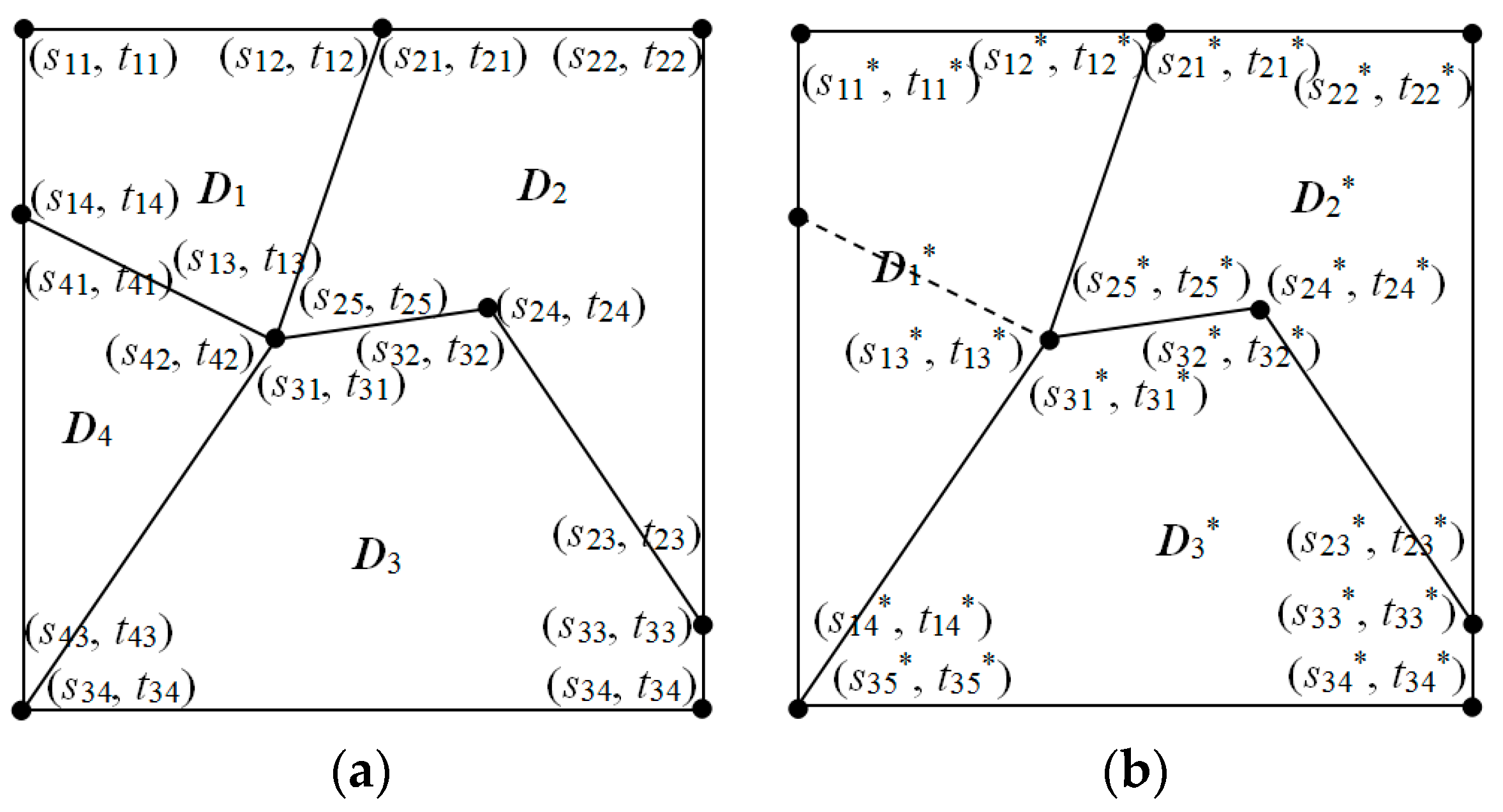
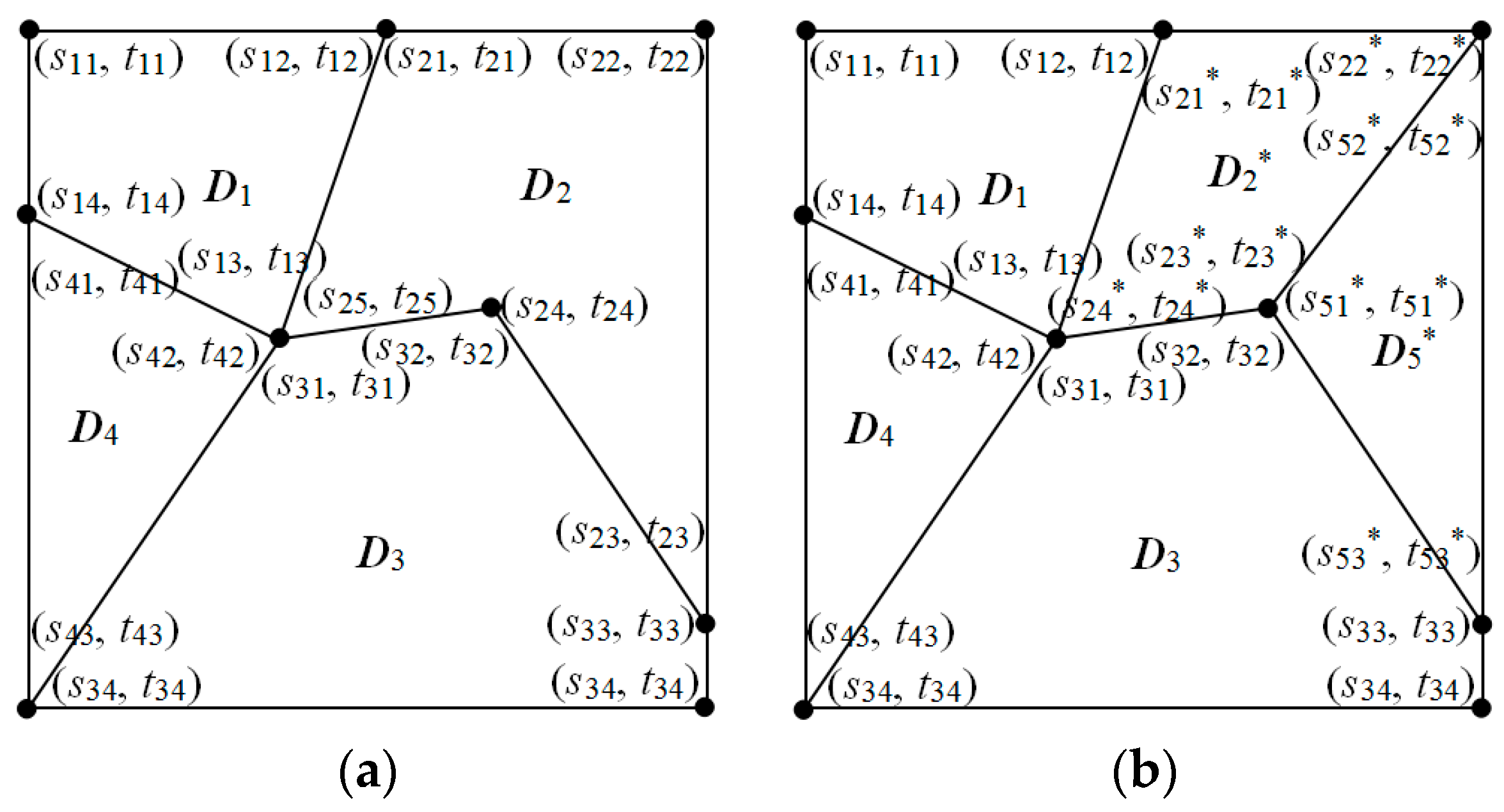
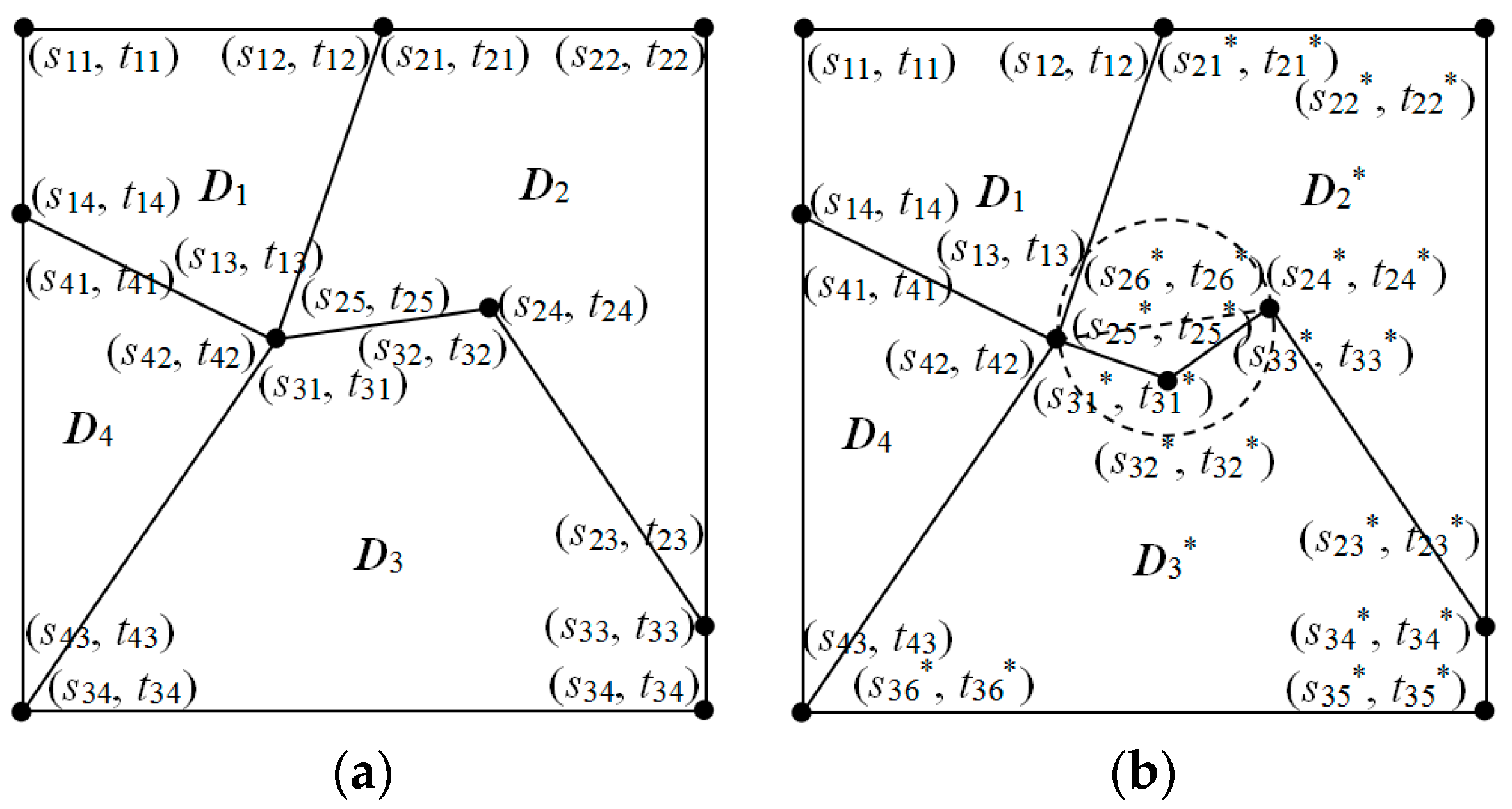




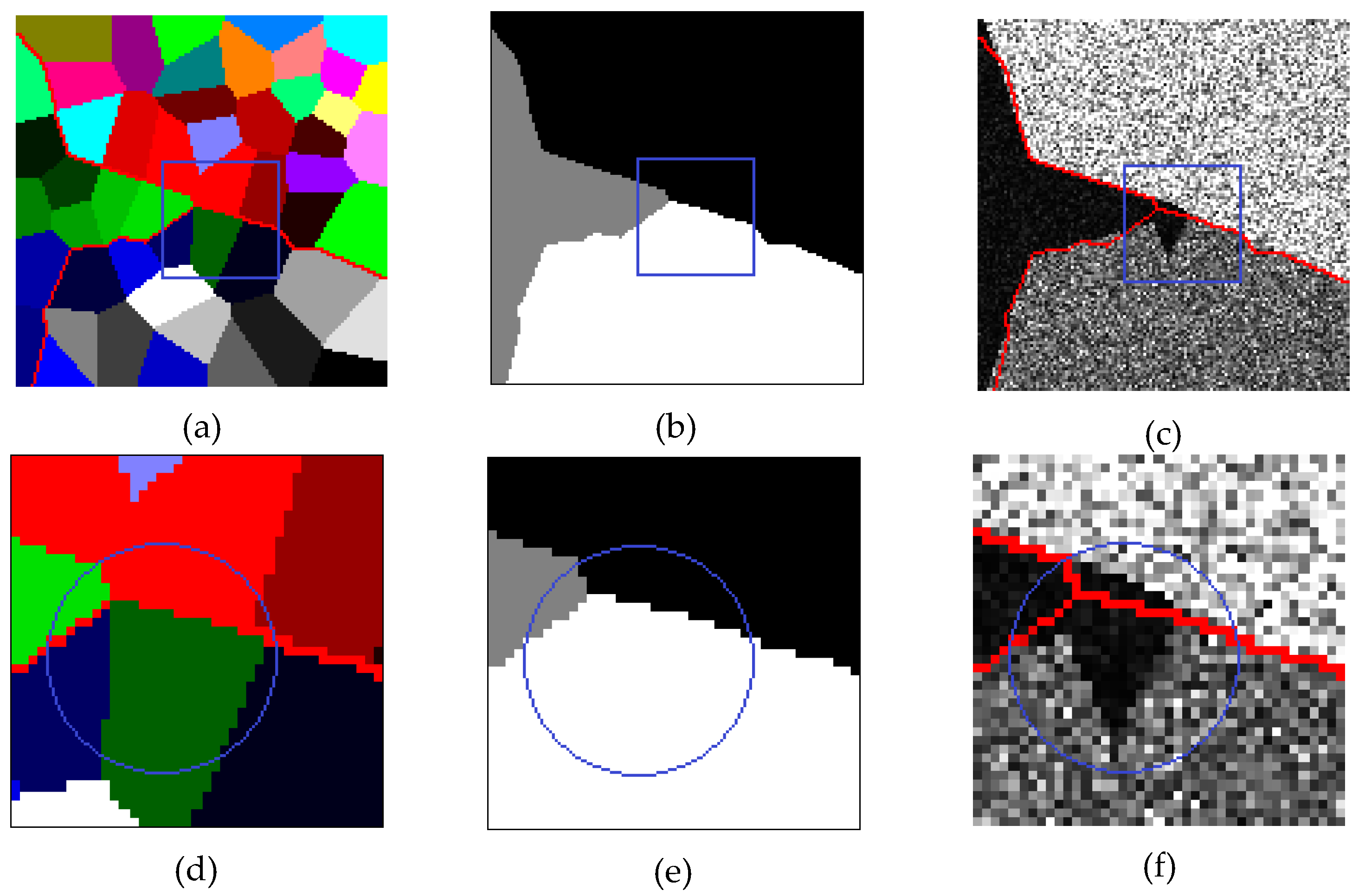
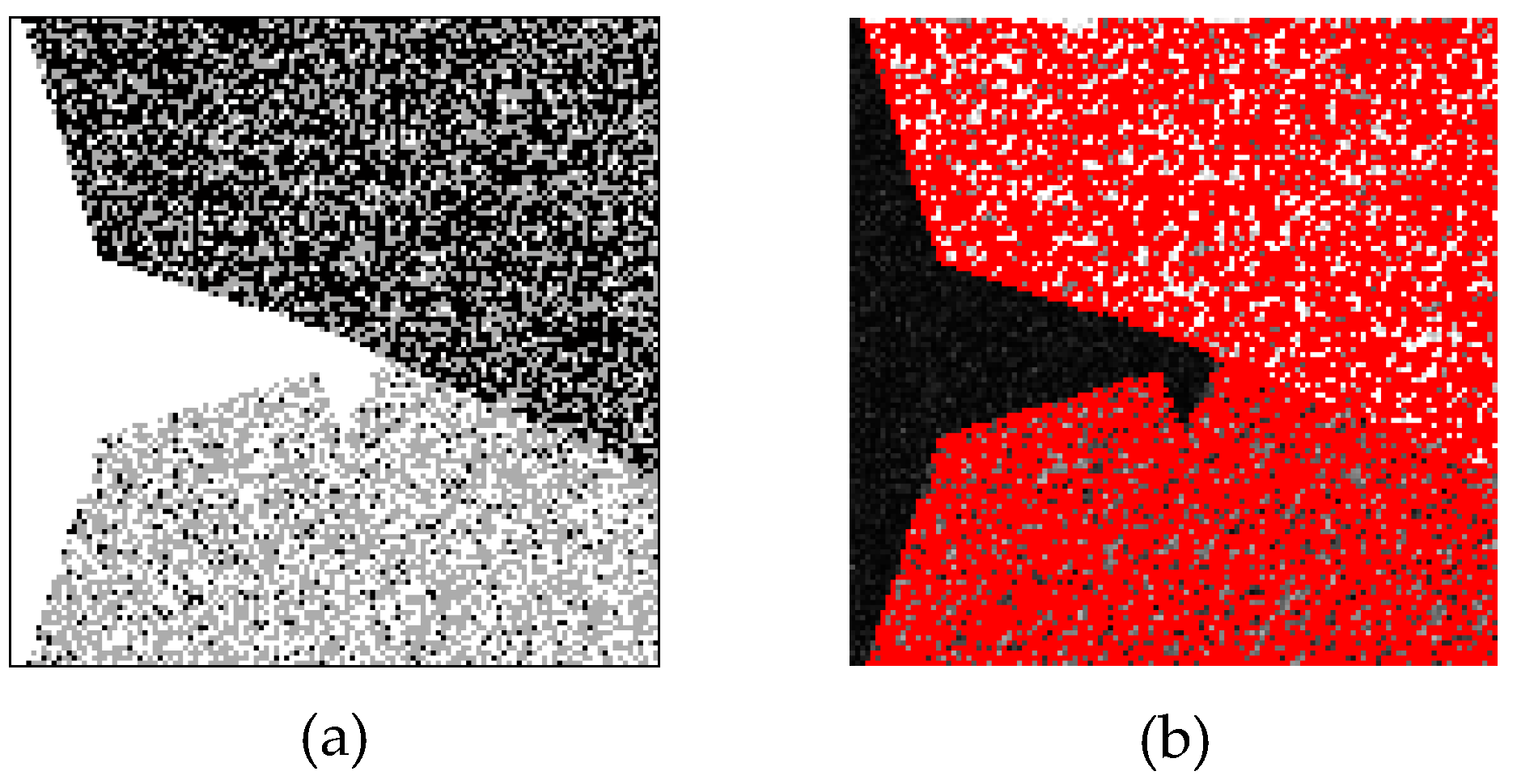



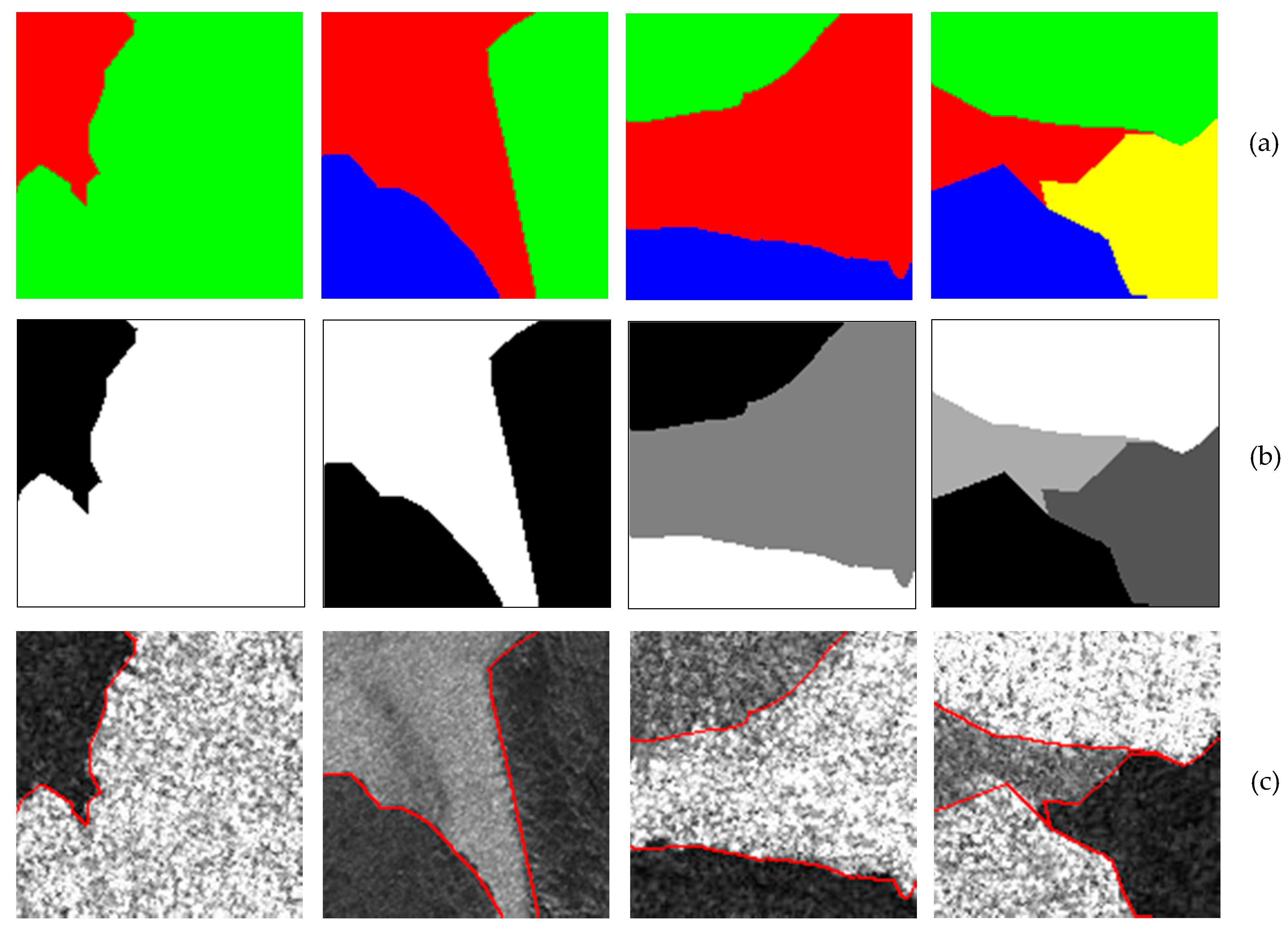
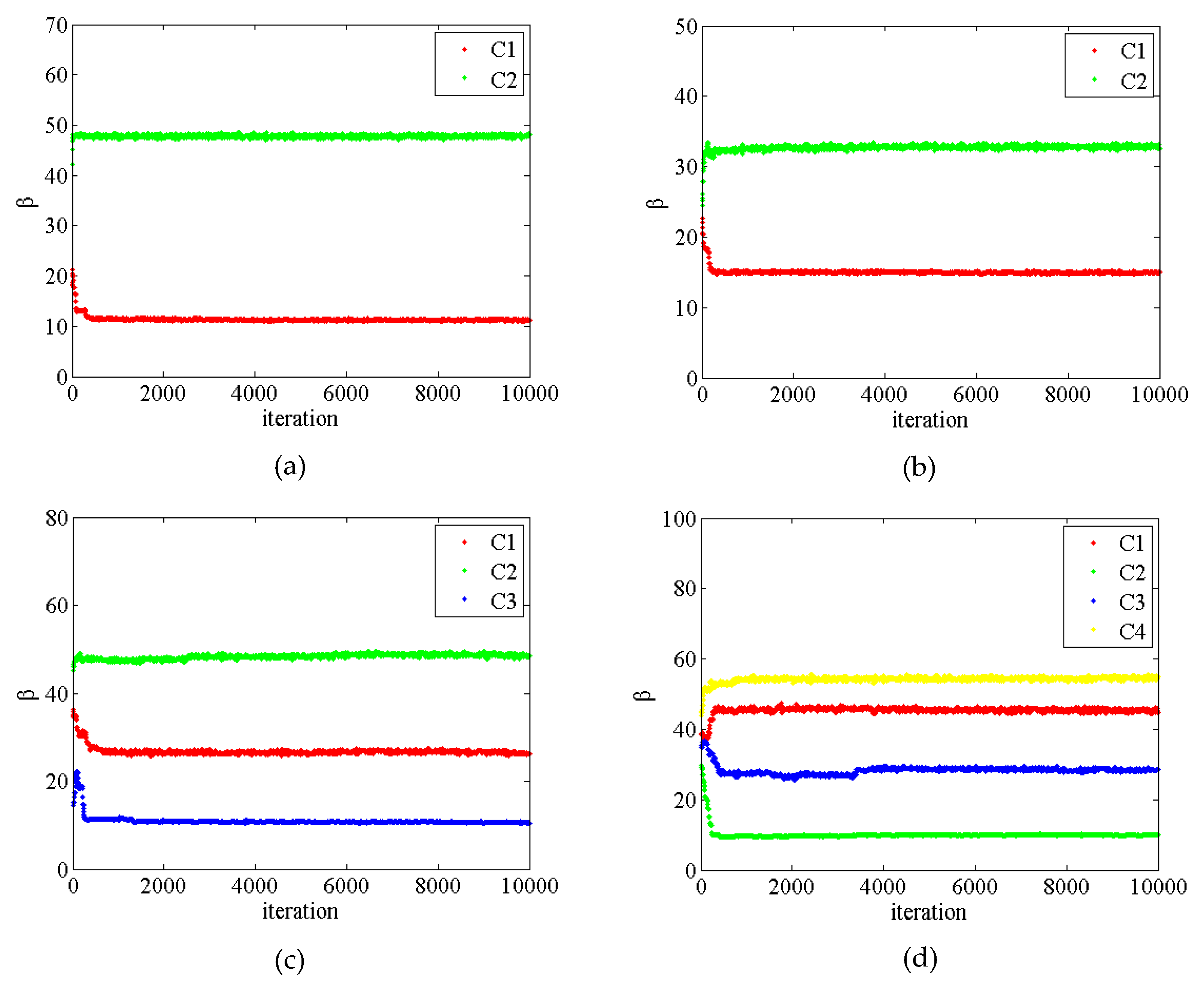
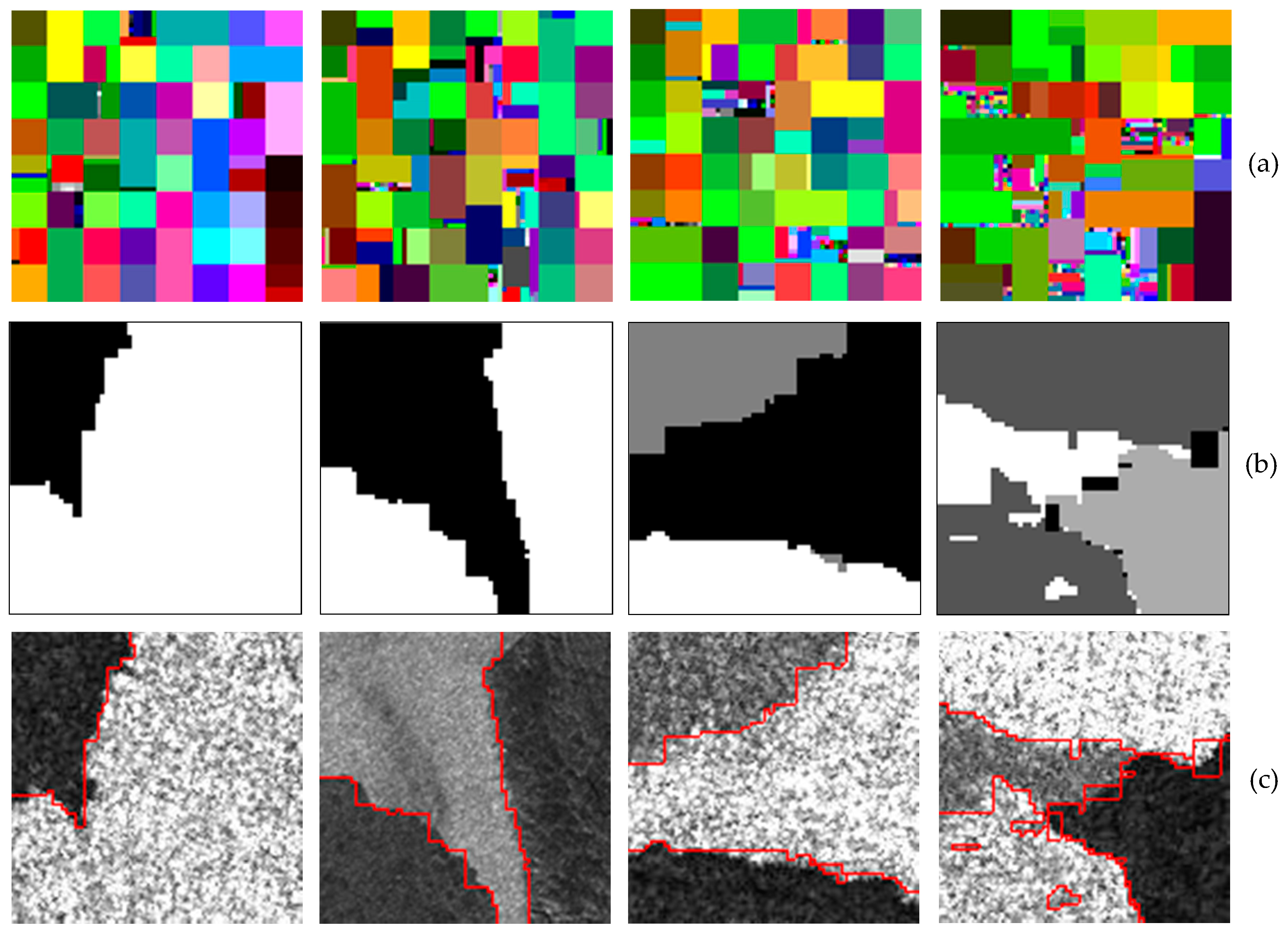
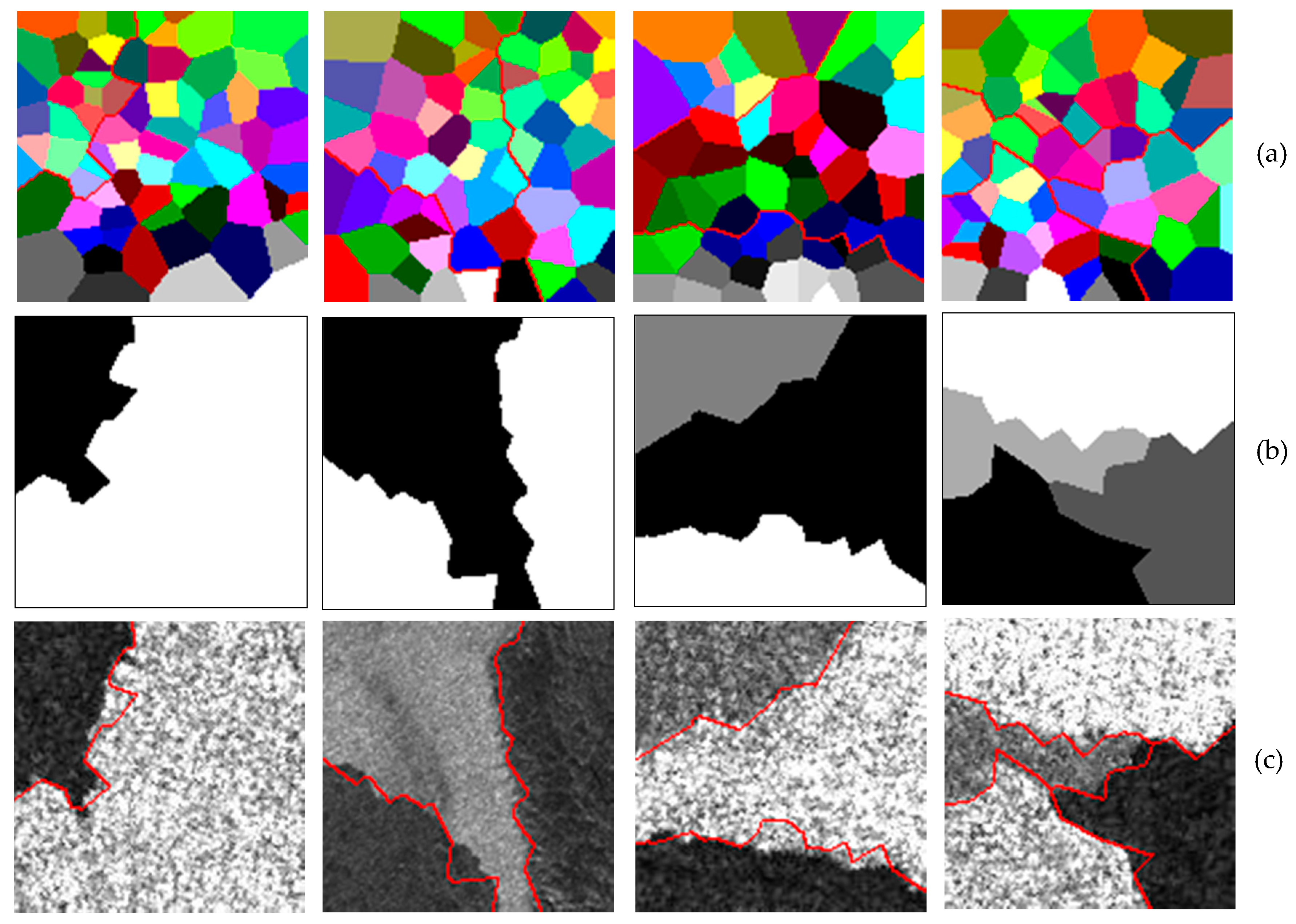
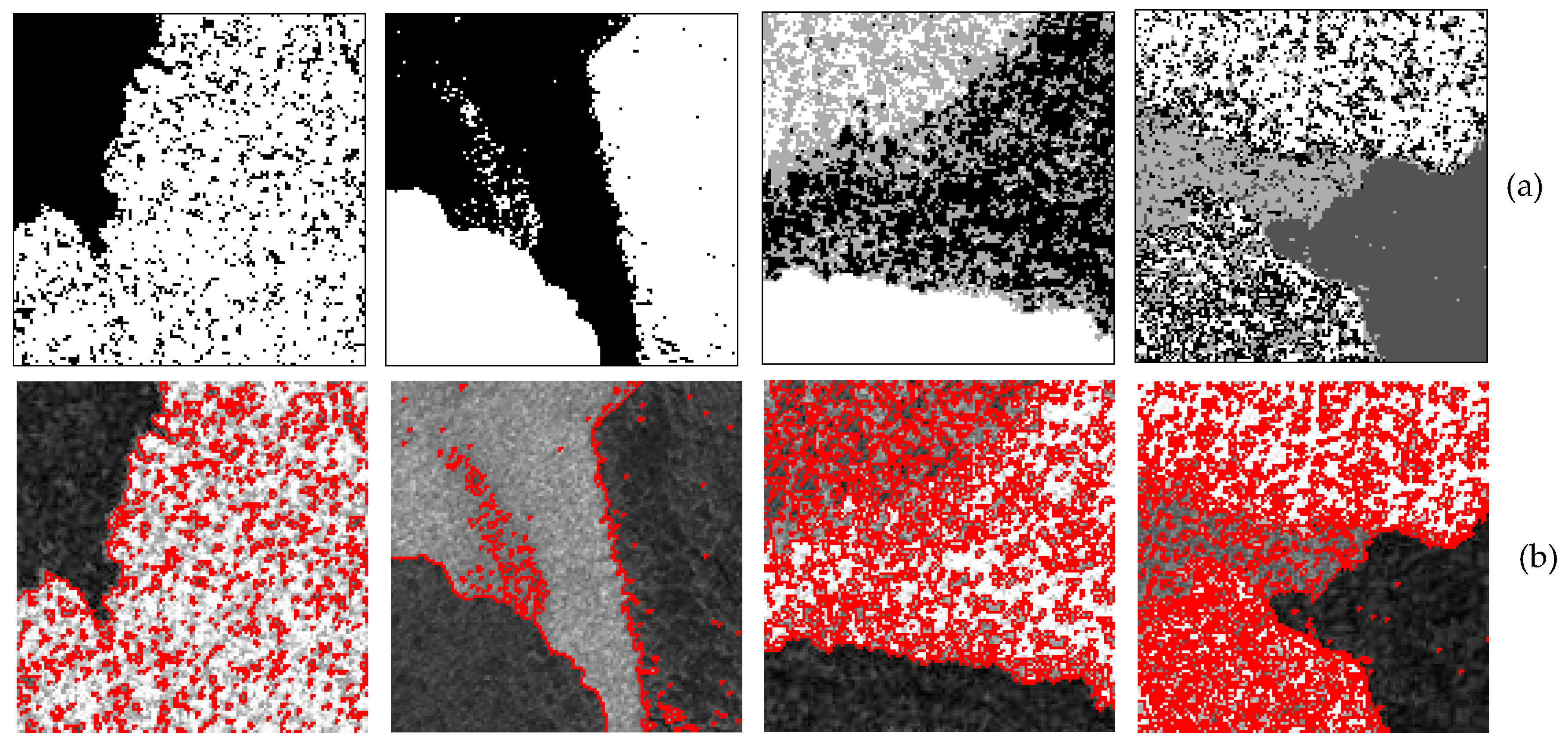
| Constants | m | c | μβ | σβ | εβ | Iteration |
|---|---|---|---|---|---|---|
| Value | 16 | 1 | 32 | 8 | 1 | 10,000 |
| Region. | I | II | III |
|---|---|---|---|
| Scale parameter (β) | 5 | 25 | 45 |
| Region | ||||
|---|---|---|---|---|
| Method | I | II | III | |
| User’s accuracy (%) | Proposed method | 98.35 | 98.76 | 98.39 |
| Regular tessellation | 83.33 | 97.45 | 99.58 | |
| Voronoi tessellation | 97.04 | 97.19 | 98.69 | |
| Multi threshold | 45.62 | 51.87 | 92.13 | |
| Producer’s accuracy (%) | Proposed method | 94.91 | 98.36 | 99.85 |
| Regular tessellation | 97.23 | 97.20 | 94.18 | |
| Voronoi tessellation | 90.81 | 98.65 | 99.71 | |
| Multi threshold | 100 | 50.43 | 57.12 | |
| Total accuracy (%) | Proposed method | 98.57 | ||
| Regular tessellation | 95.76 | |||
| Voronoi tessellation | 97.89 | |||
| Multi threshold | 61.59 | |||
| Kappa | Proposed method | 0.976 | ||
| Regular tessellation | 0.932 | |||
| Voronoi tessellation | 0.966 | |||
| Multi threshold | 0.431 | |||
| Region | ||||
|---|---|---|---|---|
| Method | I | II | III | |
| β | Proposed method | 5.36 | 25.06 | 46.56 |
| Regular tessellation | 25.77 | 29.66 | 46.25 | |
| Voronoi tessellation | 5.04 | 24.78 | 46.99 | |
| eβ (%) | Proposed method | 7.20 | 0.24 | 3.47 |
| Regular tessellation | 415.40 | 18.64 | 2.77 | |
| Voronoi tessellation | 0.80 | 0.88 | 4.42 | |
© 2020 by the authors. Licensee MDPI, Basel, Switzerland. This article is an open access article distributed under the terms and conditions of the Creative Commons Attribution (CC BY) license (http://creativecommons.org/licenses/by/4.0/).
Share and Cite
Zhao, Q.; Zhang, H.; Wang, G.; Li, Y. Irregular Tessellation and Statistical Modeling Based Regionalized Segmentation for SAR Intensity Image. Remote Sens. 2020, 12, 753. https://doi.org/10.3390/rs12050753
Zhao Q, Zhang H, Wang G, Li Y. Irregular Tessellation and Statistical Modeling Based Regionalized Segmentation for SAR Intensity Image. Remote Sensing. 2020; 12(5):753. https://doi.org/10.3390/rs12050753
Chicago/Turabian StyleZhao, Quanhua, Hongyun Zhang, Guanghui Wang, and Yu Li. 2020. "Irregular Tessellation and Statistical Modeling Based Regionalized Segmentation for SAR Intensity Image" Remote Sensing 12, no. 5: 753. https://doi.org/10.3390/rs12050753
APA StyleZhao, Q., Zhang, H., Wang, G., & Li, Y. (2020). Irregular Tessellation and Statistical Modeling Based Regionalized Segmentation for SAR Intensity Image. Remote Sensing, 12(5), 753. https://doi.org/10.3390/rs12050753





